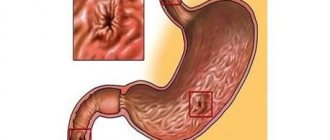Treatment of any disease is a whole complex of procedures and medications. Sometimes you look at the list and think that the doctor probably played it safe! After all, gastritis and ulcers are such studied diseases! Maybe you don’t need to take everything that is prescribed? What if we treat one thing and cripple the other?
Gastric ulcers and gastritis, although they affect the same system of the body, are different diseases. Therefore, both the principles of treatment and medications may differ, but at the same time overlap with each other. Consider tablets for gastritis and ulcers.
Compound
In one tablet: pantoprazole sodium sesquihydrate - 45.1 mg (40 mg in terms of pantoprazole ) + calcium carbonate , sodium lauryl sulfate, colloidal silicon dioxide, magnesium oxide, crospovidone, calcium stearate, triethyl citrate, titanium dioxide, macrogol 6000, methacrylic acid and ethyl acrylate in the form of a copolymer, copovidone, talc, yellow iron oxide.
One bottle contains: 40 mg of pantoprazole sodium chloride solution .
Pharmacodynamics and pharmacokinetics
The drug inhibits the process of proton transfer of H+-K+-ATPase .
hydrochloric acid is blocked at the last stage of the process, basal and stimulated secretion decreases, regardless of the origin of the specific stimulus.
If a patient has a stomach ulcer caused by the bacteria Helicobacter pylori , then by reducing the production of hydrochloric acid the sensitivity of the bacteria to antibiotics . It is noteworthy that the drug does not affect normal gastrointestinal .
After taking the tablets, the therapeutic effect occurs within an hour, reaching a maximum after 2-4 hours. 3-4 days after finishing taking the drug, the secretion of hydrochloric acid and other substances returns to normal. The substance is stable, at neutral pH it does not affect the oxidase system of the liver, which depends on the enzyme cytochrome P450 .
When taken orally, the active substance is quickly absorbed into the gastrointestinal tract . Cmax in blood plasma equal to 2-3 mcg per ml is achieved after 3 hours. About 98% of Pantoprazole is bound to plasma proteins. Parallel food intake does not affect pharmacokinetic parameters. With frequent and long-term use, this indicator remains constant.
The half-life is one hour. The drug undergoes metabolic reactions in the liver. Metabolites are excreted through the kidneys and with feces.
The drug does not accumulate in the body. For persons suffering from renal failure undergoing hemodialysis , no dose adjustment is required.
With liver cirrhosis, the half-life increases to 7-9 hours, the maximum concentration is 1.5 times higher. In elderly people, the maximum blood concentration and AUC of the drug slightly increase. However, no adjustment of the daily dose is required.
When administered intravenously, the indicators are similar to taking tablets.
Method of treating the disease
An ulcer is a violation of the integrity of the gastric mucosa.
An ulcer is a violation of the integrity of the mucous membrane of the stomach or duodenum.
There are many reasons for this disease, but the main one is infection by the microorganism Helicobacter pylori. Ulcer treatment tactics include the use of the following groups of drugs:
- Antisecretory agents
- Bismuth preparations
- Antibiotics and antibacterial agents
- Drugs that improve gastrointestinal motility
- Antacids
- Antisecretory drugs
These substances reduce the production of gastric juice and its aggressive effect on the mucous membranes. This group of drugs includes proton pump inhibitors, H2-histamine receptor blockers, M1 anticholinergics.
Proton pump inhibitors are prescribed for confirmed lesions of Helicobarker pylori. These substances reduce the aggressiveness of hydrochloric acid by up to 80%. Doctors prescribe the following drugs:
- Omez or omeprazole, zerocid – 1–2 capsules per day
- Pariet or rabeprozole – 1–2 tablets per day
- Nexium or ecomeprazole – 1–2 capsules per day
When taking drugs of this group, the effect of antibiotics and antibacterial substances increases. Take them 1 hour before meals. H2-histamine receptor blockers have a similar effect to proton pump inhibitors. You can drink them at any time, regardless of meals. Doctors prescribe:
- Ranitidine, Rantak, Zoran 150 mg 2 times a day
- Famotidine, also known as gastrosidine, blockacid, 1 capsule 2 times a day
M1 anticholinergics reduce the production of hydrochloric acid and the enzyme pepsin. Currently, the drug "Pirenzepine" is prescribed at a dose of 50 mg 2 times a day. The tablets should be taken before meals.
Indications for use
The drug is prescribed:
- with Zollinger-Ellison syndrome ;
- for the treatment and prevention of ulcers caused by stress;
- for erosive gastritis , including those associated with taking non-steroidal anti-inflammatory drugs ;
- for the treatment of GERD ;
- for the treatment of gastric and duodenal , usually in acute form;
- to eliminate the bacterium Helicobacter pylori in combination with antibiotics ;
- for the treatment of bleeding, perforations and penetrations that occur as complications of a gastric ulcer .
Antibiotics and antibacterial drugs, pyrokinetics and antacids
Antibiotics are medications aimed at suppressing Helicobacter pylori.
Among the antibiotics chosen are broad-spectrum agents - clarithromycin, tetracycline, amoxicillin.
In case of infection by a resistant strain of Helicobacter, medications are selected individually after testing for sensitivity to antibiotics.
This group of drugs is aimed at suppressing Helicobacter. Trichopolum or metronidazole is traditionally used as an antibacterial drug.
If Helicobacter is not detected, and the ulcer is caused by other reasons, then antibiotics are not used for treatment. Pyrokinetics improve the movement of food through the gastrointestinal tract, relieve dyspepsia, heartburn, and a feeling of heaviness in the stomach. Traditionally, cerucal, metoclopramide, and motilium are prescribed. These drugs are not used to treat ulcers on their own.
Antacids are prescribed to relieve heartburn. The choice of these drugs is huge - Maalox, Gastral, Almagel. The course of taking antacids should not exceed 14 days. Additionally, patients are prescribed vitamin complexes, antispasmodics – no-spa, drotaverine, baralgin.
In case of a mild condition, treatment is carried out on an outpatient basis. In severe cases - bleeding, suspected perforation - only in a medical institution.
Contraindications
The medicine is not prescribed:
- for indigestion caused by neurotic disorders;
- children;
- if you are allergic to the components of the product;
- for oncological diseases of the stomach and intestines.
In the presence of liver disease, liver cirrhosis and during pregnancy, the medicine is prescribed with caution.
special instructions
Before starting therapy and after its completion, endoscopic monitoring is required to exclude malignant tumors of the esophagus or stomach, since treatment with Sanpraz can mask the symptoms of the disease and delay the correct diagnosis.
For the treatment of dyspepsia of neurogenic origin, the use of the drug is not effective.
If any of the alarming symptoms are present (recurrent vomiting, melena, significant weight loss, anemia, dysphagia) and if an ulcer is suspected, or in the case of an existing gastric ulcer, it is necessary to exclude the presence of a malignant neoplasm. If symptoms persist with adequate treatment, further diagnosis should be performed.
Sanpraz does not affect the ability to drive vehicles or perform other work that requires increased concentration and quick reaction.
Side effects
When taking the medicine you may experience:
- depression , headache , disorientation , hallucinations and confusion ;
- thrombocytopenia , leukopenia ;
- thrombophlebitis and phlebitis ;
- epigastric pain, constipation or diarrhea , nausea, flatulence , dry mucous membranes, jaundice , increased levels of liver enzymes;
- arthralgia , myalgia ;
- urticaria , skin itching , anaphylactic shock , erythema , angioedema , photosensitivity , Stevens-Johnson syndrome ;
- triglyceride levels , nephritis .
Instructions for use of Sanpraz (method and dosage)
Depending on the patient’s condition, the doctor must prescribe one or another dosage form.
Sanpraz tablets, instructions for use
The tablets are taken orally with liquid, without biting or crushing them. It is best to take the medicine in the morning, on an empty stomach, an hour before the first meal.
For stomach ulcers, 40-80 mg per day is prescribed for treatment and 20 mg per day for prevention. Duration of treatment is 4-8 weeks.
For duodenal ulcers and erosive gastritis , the daily dosage is 40-80 mg; for prevention, 20 mg of the drug per day is also taken. The course of treatment is half a month.
To eradicate Helicobacter bacteria, 80 mg per day is prescribed in 2 doses. Duration of treatment is 7-14 days. In parallel, antibiotics are usually prescribed.
For gastrointestinal erosion caused by taking NSAIDs , the daily dosage is 40-80 mg, 20 mg for prevention. The course of treatment is up to 2 months.
For the treatment of reflux esophagitis, 20-40 mg of the drug per day is used. For prevention – 20 mg. Duration of treatment is 4-8 weeks.
Instructions for solution for intravenous administration
This form of medication is prescribed when it is impossible to use tablets. As soon as this becomes possible, switch to tablet form.
To prepare the solution, you must mix the contents of the bottles.
The solution is administered in a stream or through a dropper. The injection time is from 2 to 15 minutes, the pH of the solution is 9-10. After 3 hours, the prepared solution becomes unsuitable for administration.
As a rule, use 40 mg (one bottle) per day. It is permissible to make intravenous injections for 7-10 days. The maximum amount of the drug per day is 80-160 mg. The dose should be divided into 2 injections.
If the patient has severe liver dysfunction, the maximum daily dosage is 20 mg. Liver enzyme levels should be closely monitored during treatment.
If the patient is on hemodialysis or is elderly, the dosage should not exceed 40 mg per day.
Interaction
The combination of Sanpraz with ketoconazole , ritonavir and iron salts reduces their absorption due to changes in the pH of gastric juice.
The medicine can be combined with digoxin , metoprolol , clarithromycin , diclofenac , naproxen , glibenclamide , diazepam, phenytoin, tacrolimus, midazolam, theophylline, ethanol, caffeine, Nifedipine, amoxicillin, oral contraceptives, phenazole, piroxicam, levothyroxine sodium, carbamazepine, cyclosporine, cisapride, metronidazole .
When taking the drug and atazanavir , the effectiveness of the latter is reduced.
If you take the medicine and Warfarin the prothrombin index changes , and bleeding may occur. In this regard, PTI must be carefully monitored.
Bismuth preparations
De-Nol
Medicines based on bismuth have a coating effect on the inner lining of the stomach, protecting it from the action of gastric juice.
In addition, bismuth preparations suppress the growth and reproduction of Helicobacter. Doctors prescribe the following drugs:
- Vikalin
- De-nol
- Bismuth nitrate
Ranitidine bismuth citrate is a complex preparation of bismuth with an H2-histamine receptor blocker. All these medications are taken 1–1.5 hours after meals. Bismuth preparations color feces black. This is not a contraindication for further treatment with bismuth.
Sanpraz's analogs
Level 4 ATC code matches:
Khairabesol
Noflux
Lancid
Barol
Beret
Ontime
Gastrozol
Omeprazole
Pantoprazole
Proxium
Lansoprazole
Zulbex
Ultop
Epicurus
Pariet
Losek MAPS
Losek
Emanera
Omez Insta
Omez
The analogues of Sanpraz that are closest in action are: Zipantol, Controloc, Peptazol, Panum, Omez, Nolpaza, Proxium .



